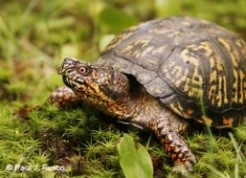Wildlife
Lobster and Fishes Clamming and Oystering Piping Plovers Raptors Forest Birds
Resident Turtles

Five of the eight turtle species that live in Connecticut year-round are listed as endangered, threatened, or of special concern.
 Turtles are excellent indicators of ecological health. This indicator includes the eight species of turtle that live in Connecticut (but not the four marine species that visit Long Island Sound in summer, all of which are threatened or endangered). In 2015, five of the eight resident turtle species were listed as endangered or of special concern: bog turtle (endangered), eastern box turtle, wood turtle northern, diamondback terrapin, and spotted turtle (species of special concern).56 Turtle species in Connecticut have declined, in part, because of poaching, and the degradation and segmentation of their habitat. The ability for turtles to sustain a stable population will be difficult because turtles take a long time to reach sexual maturity and have low survivorship when newly hatched.
Turtles are excellent indicators of ecological health. This indicator includes the eight species of turtle that live in Connecticut (but not the four marine species that visit Long Island Sound in summer, all of which are threatened or endangered). In 2015, five of the eight resident turtle species were listed as endangered or of special concern: bog turtle (endangered), eastern box turtle, wood turtle northern, diamondback terrapin, and spotted turtle (species of special concern).56 Turtle species in Connecticut have declined, in part, because of poaching, and the degradation and segmentation of their habitat. The ability for turtles to sustain a stable population will be difficult because turtles take a long time to reach sexual maturity and have low survivorship when newly hatched.
Goal: The goal for all endangered and threatened species is for recovery of their populations to a stable, sustainable level.
——————————
Bats

Eight of the nine bat species are on the latest list of species that are endangered, threatened, or of special concern.
 Bat populations in Connecticut have experienced a catastrophic decline that led to the classification in 2015 of three more bat species as endangered in Connecticut and has raised concerns about the future of bats in the state. This decline in bat population, between 2007 and 2010, is primarily due to an epidemic fungal disease called white-nose syndrome (WNS). The chart depicts data for the winter population of three cave-dwelling bat species at a sentinel hibernation site monitored annually by the Department of Energy and Environmental Protection (DEEP).57 This sentinel cave is one of Connecticut’s best remaining overwintering site for cave bats. While there were no bat surveys performed in 2021 due to COVID-19, recovery, if one occurs, will be slow: adult female bats usually produce just one pup per year. Bats eat insects, including mosquitoes, a number of which may carry diseases that affect humans, birds, horses and other animals.
Bat populations in Connecticut have experienced a catastrophic decline that led to the classification in 2015 of three more bat species as endangered in Connecticut and has raised concerns about the future of bats in the state. This decline in bat population, between 2007 and 2010, is primarily due to an epidemic fungal disease called white-nose syndrome (WNS). The chart depicts data for the winter population of three cave-dwelling bat species at a sentinel hibernation site monitored annually by the Department of Energy and Environmental Protection (DEEP).57 This sentinel cave is one of Connecticut’s best remaining overwintering site for cave bats. While there were no bat surveys performed in 2021 due to COVID-19, recovery, if one occurs, will be slow: adult female bats usually produce just one pup per year. Bats eat insects, including mosquitoes, a number of which may carry diseases that affect humans, birds, horses and other animals.
Goal: The goal for bats is for recovery of all nine species to a stable, sustainable population.
Technical Note: The horizontal axis for bats displays every other year between 1999 and 2007.
—————
56 DEEP, Endangered, Threatened and Special Concern Reptiles; portal.ct.gov/DEEP/Endangered-Species/Endangered-Species-Listings/Endangered-Threatened--Special-Concern-Reptiles.
57 DEEP, Wildlife Division, Wildlife Diversity Program, and State and Tribal Wildlife Grants programs; personal communication from B. Hess, February 17, 2021. No data for 2022 per B. Hess February 14, 2022.

